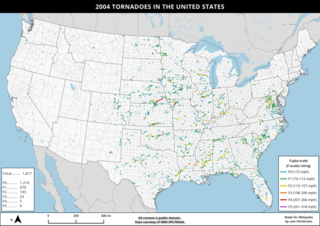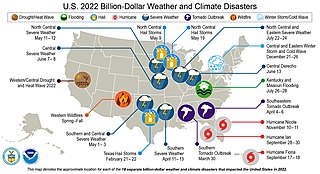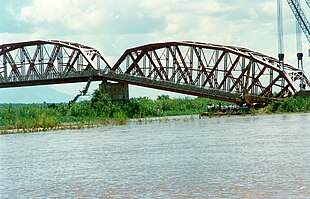
This page documents notable tornadoes and tornado outbreaks worldwide in 2006. Strong and destructive tornadoes form most frequently in the United States, Bangladesh, and Eastern India, but they can occur almost anywhere under the right conditions. Tornadoes also develop occasionally in southern Canada during the Northern Hemisphere's summer and somewhat regularly at other times of the year across Europe, Asia, Argentina, Brazil and Australia. Tornadic events are often accompanied with other forms of severe weather, including strong thunderstorms, strong winds, and hail.
The 1972 Portland–Vancouver tornadoes were caused by an unusually intense squall line with embedded strong tornadoes that struck Oregon and Washington on Wednesday, April 5, 1972. Of the four tornadoes, the most catastrophic event was a deadly F3 tornado that struck Portland, Oregon, and Vancouver, Washington, the first F3 tornado to strike Oregon since June 3, 1894. It tracked 8.7 miles (14.0 km) across the heavily populated Portland–Vancouver metropolitan area, causing heavy damage, killing six people, and injuring 300 while causing $25.25 million in damage. It was tied as the deadliest tornado in the United States in 1972 and remains the deadliest tornado in the history of the Pacific Northwest. In all, the outbreak killed six, injured 301, and caused $25.55 million in damage.

This page documents notable tornadoes and tornado outbreaks worldwide in 2004. Strong and destructive tornadoes form most frequently in the United States, Bangladesh, and Eastern India, but they can occur almost anywhere under the right conditions. Tornadoes also develop occasionally in southern Canada during the Northern Hemisphere's summer and somewhat regularly at other times of the year across Europe, Asia, and Australia. Tornadic events are often accompanied with other forms of severe weather, including strong thunderstorms, strong winds, and hail.

This page documents the tornadoes and tornado outbreaks of 2002, primarily in the United States. Most tornadoes form in the U.S., although some events may take place internationally. The year had several large outbreaks that included the Veterans Day Weekend tornado outbreak and the Midwest to Mid-Atlantic United States tornado outbreak.

This page documents the tornadoes and tornado outbreaks of 1972, primarily in the United States. Most tornadoes form in the U.S., although some events may take place internationally. Tornado statistics for older years like this often appear significantly lower than modern years due to fewer reports or confirmed tornadoes.

This page documents the tornadoes and tornado outbreaks of 1970, primarily in the United States. Most tornadoes form in the U.S., although some events may take place internationally. Tornado statistics for older years like this often appear significantly lower than modern years due to fewer reports or confirmed tornadoes.

The following is a list of weather events that occurred on Earth in the year 2020.

The following is a list of weather events that occurred in 2021. The year began with La Niña conditions. There were several natural disasters around the world from various types of weather, including blizzards, cold waves, droughts, heat waves, tornadoes, and tropical cyclones. In December, powerful Typhoon Rai moved through the southern Philippines, killing 410 people and becoming the deadliest single weather event of the year. The costliest event of the year, and the costliest natural disaster on record in the United States, was from a North American cold wave in February 2021, which caused $196.4 billion (USD) in damage; the freezing temperatures and widespread power outages in Texas killed hundreds of people. Another significant natural disaster was Hurricane Ida, which struck southeastern Louisiana and later flooded the Northeastern United States, resulting in $70 billion (USD) in damage. December saw two record-breaking tornado outbreaks, only four days apart from each other. In Europe, the European Severe Storms Laboratory documented 1,482 weather-related injuries and 568 weather-related fatalities. The National Oceanic and Atmospheric Administration documented 796 weather-related fatalities and at least 1,327 weather-related injuries in the United States and the territories of the United States.

The following is a list of weather events that occurred on Earth in the year 2022. The year began with a La Niña. There were several natural disasters around the world from various types of weather, including blizzards, cold waves, droughts, heat waves, wildfires, floods, tornadoes, and tropical cyclones. The deadliest weather event of the year were the European heat waves, which killed over 26,000 people, 11,000 of which were in France. The costliest weather event of the year was Hurricane Ian, which caused at least $112.9 billion in damages in Florida and Cuba. Another significant weather event was the Pakistan floods, which killed 1,739 people and a total of $14.9 billion in damages.
The following is a list of weather events in 2019.

The following is a list of weather events that occurred in 2018.

The following is a list of weather events that occurred in 2017.

The following is a list of weather events that occurred on Earth in the year 2004. There were several natural disasters around the world from various types of weather, including blizzards, cold waves, droughts, heat waves, tornadoes, and tropical cyclones. The deadliest disaster was Hurricane Jeanne, which killed more than 3,000 people when it struck Hispaniola, mostly in Haiti. This was just four months after flooding in Hispaniola killed 2,665 people. Jeanne was also the fourth hurricane to strike the United States in the year, following Charley, Frances, and Ivan. Ivan was the costliest natural disaster of the year, causing US$26.1 billion in damage in the Caribbean and the United States.

The following is a list of weather events that occurred on Earth in the year 1985. The year began with a La Niña. The most common weather events to have a significant impact are blizzards, cold waves, droughts, heat waves, wildfires, floods, tornadoes, and tropical cyclones. The deadliest weather event of the year was the Ethiopia famine, which killed at least 400,000. The costliest weather event of the year was Hurricane Juan, which caused around $1.5 billion in damages in the Southern United States. Another significant weather event was the Bangladesh cyclone in May, which killed 11,069 people and damaged nearly 100,000 houses.
The following is a list of weather events that occurred on Earth in the year 2001. There were several natural disasters around the world from various types of weather, including tornadoes, floods and tropical cyclones. The deadliest disaster was Typhoon Lingling in November, which caused 379 fatalities. The costliest event of the year was Hurricane Michelle, which caused $2.43 billion in damages.














